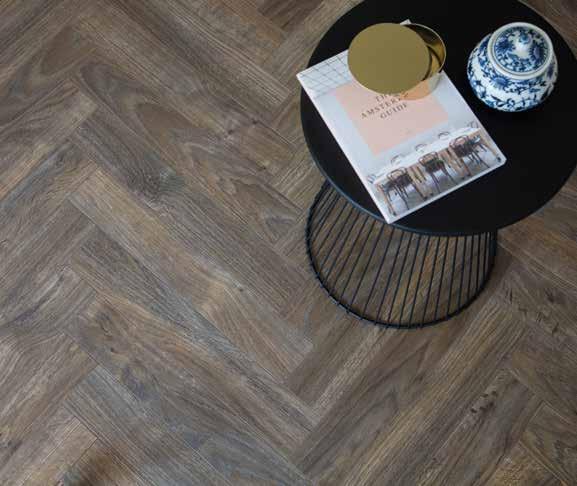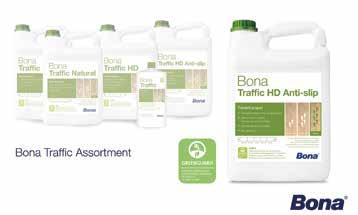
7 minute read
Special Colour stains and their assets
A QUESTION OF PERSONAL TASTE
YOUR CHOICE DEPENDS LARGELY ON THE LOOK REQUIRED
Advertisement
In the previous edition we concentrated specifically on reactive stains. In this edition, in the second part of this article, we consider the practical application of these reactive stains, but at the same time we’re also going to consider colour stains.
There’s no need any more for us to explain the difference between stains and lacquers. Suffice it to say that staining is an excellent treatment for a wooden floor, but obviously only after sanding the wood first. For instance, it can provide the perfect solution for restoring gloss and colour once the floor becomes dull. Remember that stains regulate moisture very well and that they are therefore suitable for substrates which may be a little damper than normal. With a stain, the stain coat can drive out damp, so that also makes stains ideal for outdoor use.
Coloured or transparent
With staining, there is a choice of a transparent or colour version. There are good reasons for choosing one over the other. With a transparent stain, the wood grain remains perfectly visible and the stain gives the floor a natural look. With a coloured stain, the floor stain provides a protective layer. In this case you have a choice of three types of stains, namely gloss, silky gloss, and matt.
The preparation for staining is absolutely essential. It won’t work without a smooth and sturdy substrate. That means not only sanding, but also removing all imperfections. This includes, for instance, driving visible nails deep into the wood, repairing creaking parts, and filling in holes using putty. Moreover, and perhaps most importantly, don’t forget to remove any grease from the floor before you start and vacuum clean thoroughly if the floor has been sanded.
When you apply a stain, you can apply the first coat with a roller and then use a brush for the edges and corners. Don’t forget to apply the stain in the direction of the wood grain! Sand lightly after the application of each coat; the number of coats depends on the intensity which you require.
Applying reactive stains
What we haven’t yet considered in depth is how to apply so called reactive stains. The general rule here is that you do it in the same way as you apply so called ‘classic’ stains, namely in contact with the wood and without a primer. You need to sand the floor thoroughly and then apply the reactive stain (which is also called ‘positive’ because it reacts differently to classic stains and works more into the hard fibres rather than the soft ones) with a roller or, if necessary, a spray gun, although the latter is of little use on parquet which is already laid. It is advisable to apply a thin coat in the direction of the fibres, and not to rub with a single brush in order to obtain the best possible effect (which would be tempered and obscured by the brushing).
Another question is what to use as a top layer. Since these colours are usually water-based, they are sensitive to water. And so, it is not advisable to apply a primer, a sealant, a varnish, or an oil in water phase. It is technically possible to ‘block’ the resulting tint with a solvent primer, but that reduces the decorative effect to some extent. Therefore, it is best to use a traditional (solvent) oil in a neutral tint or in harmony with the reactive tint or in contrast to it. All decorative effects are possible.
Difference with coloured oils
The final question is to consider what actually is the difference with coloured oils. Here you have to remember that tinted oils impregnate the wood fibres and apply a coat to provide decoration and protection in one treatment. Reactive stains work by separating the fibres according to their type (in fact, depending on whether they are summer or winter fibres), the quantity, and nature of the tannic acid in the wood, the quality of the sanding, and, if necessary, the defects which are in evidence on the planks. Reactive stains should always be covered, since they don’t have the capacity to protect the wood, but serve only to apply a decoration, a shade, or an atmosphere.
This text has been written partly with the help of Blanchon.
What’s on the market ?
Blanchon
Blanchon has presented a full range of oils, wax oils, and hard wax oils for over 20 years. In diverse ranges, with scores of nuances, it is possible to order about a hundred shades for delivery within a week. That gives clients a huge choice, but, actually, the possibilities are infinite, since the oil is often applied to parquet with some form of colour, such as with certain distressing techniques.The full assortment for colouring, decorating, and distressing parquet and woodwork includes amongst other things Aquateinte 2K, a water-based colouring specially for parquet. There are diverse wood colours and diverse colours ranging from sheer white to deep black. For small surfaces, specially for parquet, there is ‘Teinte à Bois’ (wood shade), which is applied before glazing or varnishing. Teinte à Bois is a polyurethane tint in a watery phase; it is odourless and dissolves in water. We should also mention Vieillisseur Bois (wood ageing). This colours all furniture, parquet floors, wooden panelling, and such like and gives the wood a ‘waxed’ and ‘patinated’ look. It highlights the contrasts of the wood grain and thereby provides an antique and distressed effect.
Bona
Bona Nordic Tone and Bona Rich Tone (Grey) are pre-treatment products for Bona Craft Oil (1 and 2 components). The colours Bona Nordic Tone and Bona Rich Tone (Grey) can be changed or reinforced by the addition of Bona Mix Colour to achieve the widest spectrum of colours and shades. You can combine the newly made colour with a Bona Craft Oil colour or a newly made contrasting colour for spectacular two-dimensional effects. BONA NORDIC TONE is a pre-treatment for Bona Craft Oil (1 and 2 components) for a Scandinavian look. It gives intense white highlights and averts any discolouration of the surface. BONA RICH TONE (GREY) is a pre-treatment for Bona Craft Oil (1 and 2 components). It gives the floor a smoked look; with the Grey version there is a rich dark-grey colour to give the floor a touch of refinement. BONA MIX COLOUR is a concentrated stain paste for water-based systems and specifically for Bona Nordic Tone and Bona Rich Tone (Grey). As regards percentages, you can adapt the colour yourself.
Chimiver

LIOS B 100 COLORATO Colored oil treatment for wooden floors LIOS B 100 is a natural oil treatment for wooden floors, it has 100% solid content so it can be considered VOC free. LIOS B 100 protects the wood, enhancing the softness and the natural look of the wood.
Osmo

Osmo Oil Stain: attractive colours – transparent or intense Wooden flooring, furniture surfaces and stairs can be stained in a transparent or intense colour with Osmo Oil Stain. Through the use of plant ingredients, an even colour as well as a harmonious appearance, without any visible transitions is achieved. A transparent colour is created with one thin coat of Osmo Oil Stain; a further coat produces an intense colour. This product offers a wide colour spectrum from classic browns to trendy greys. To protect the floor optimally and durably, Osmo recommends a finishing coat with a clear Osmo Polyx®-Oil.
Pallmann

Colouring and individualization of wood floors is a huge trend and becomes an element to express individuality and uniqueness. The rapid growth in the market of coloured/stained floors reflects customers increasing needs to have something different for their wood floors. The parquet industry should not miss out on this potential. With the PALLMANN Color Collection PALLMANN provides a range of 24 coloured oil primers. Each color consists of 3 components: The 2K oil primer PALL-X 333 A / B is given a color C concentrate as a third and final component: This combination is suitable for the priming and simultaneous colouring of many commercial wood types, especially oak, ash, pine on site. It is also helpful for wood types whose natural pigments are not UV-stable and whose colour change intensively or become optically unattractive over time. The surface can then be protected with the PALLMANN 2-component water-based wood floor coatings as well as with the 2-component wood floor oil.
Tover
Tover can offer several extremely innovative pre-colouring systems to create endless tailor-made finishing solutions: Belle Epoque, our water-based stain available in 15 shades of gray, sand, light or dark brown and caramel, all overcoatable with our neutral or coloured oils for two-colour effects or with our lacquers for an extremely resistant result. Then you can count on a full range of reagents in aqueous phase which give an aged gray, black or bleached appearance to treated wood: Bosch Vej, Ciair, Fossil. And why not dare to use an oil-based primer available in 30 colours for a raw or modern wood effect, that you can overcoat with a two-component Tintoretto Design water-based lacquer. Tover - Innovation at the service of colour!











